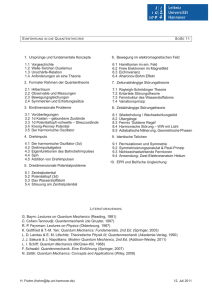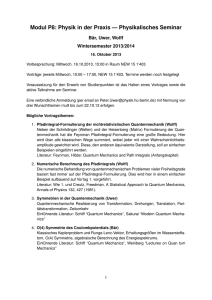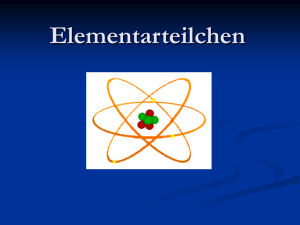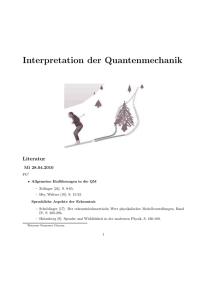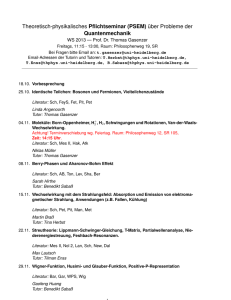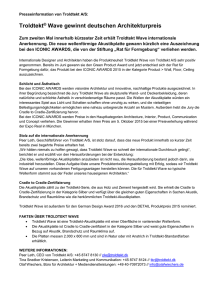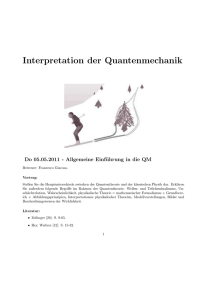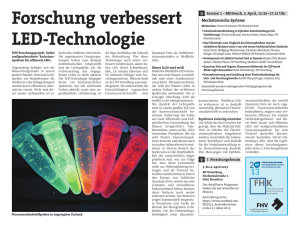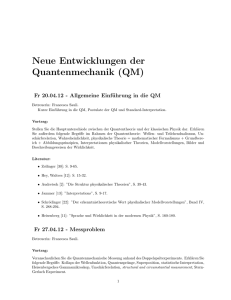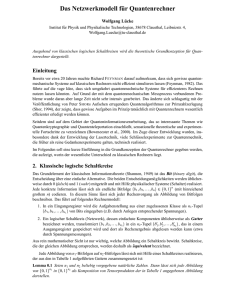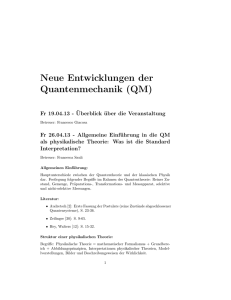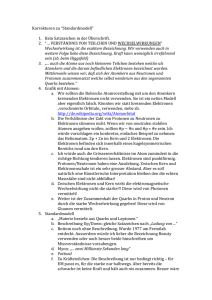Quantenmechanik - Plan B Quantum mechanics
Werbung
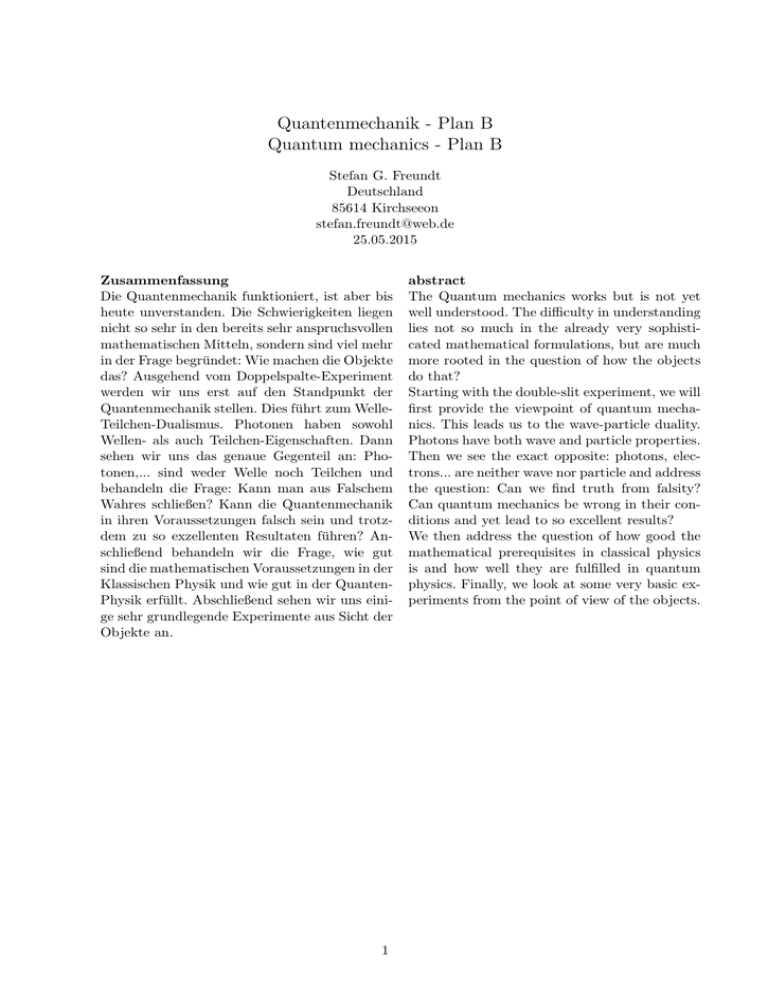
Quantenmechanik - Plan B Quantum mechanics - Plan B Stefan G. Freundt Deutschland 85614 Kirchseeon [email protected] 25.05.2015 Zusammenfassung Die Quantenmechanik funktioniert, ist aber bis heute unverstanden. Die Schwierigkeiten liegen nicht so sehr in den bereits sehr anspruchsvollen mathematischen Mitteln, sondern sind viel mehr in der Frage begründet: Wie machen die Objekte das? Ausgehend vom Doppelspalte-Experiment werden wir uns erst auf den Standpunkt der Quantenmechanik stellen. Dies führt zum WelleTeilchen-Dualismus. Photonen haben sowohl Wellen- als auch Teilchen-Eigenschaften. Dann sehen wir uns das genaue Gegenteil an: Photonen,... sind weder Welle noch Teilchen und behandeln die Frage: Kann man aus Falschem Wahres schließen? Kann die Quantenmechanik in ihren Voraussetzungen falsch sein und trotzdem zu so exzellenten Resultaten führen? Anschließend behandeln wir die Frage, wie gut sind die mathematischen Voraussetzungen in der Klassischen Physik und wie gut in der QuantenPhysik erfüllt. Abschließend sehen wir uns einige sehr grundlegende Experimente aus Sicht der Objekte an. 1 abstract The Quantum mechanics works but is not yet well understood. The difficulty in understanding lies not so much in the already very sophisticated mathematical formulations, but are much more rooted in the question of how the objects do that? Starting with the double-slit experiment, we will first provide the viewpoint of quantum mechanics. This leads us to the wave-particle duality. Photons have both wave and particle properties. Then we see the exact opposite: photons, electrons... are neither wave nor particle and address the question: Can we find truth from falsity? Can quantum mechanics be wrong in their conditions and yet lead to so excellent results? We then address the question of how good the mathematical prerequisites in classical physics is and how well they are fulfilled in quantum physics. Finally, we look at some very basic experiments from the point of view of the objects. Inhaltsverzeichnis 1 Einleitung / Introduction / Motivation 3 2 Doppelspalt-Experiment / Double-Slit Experiment 4 3 Plan A: sowohl Welle als auch Teilchen / wave-particle duality 4 4 Plan B: weder Welle noch Teilchen / neither wave nor particle 5 5 Kann man aus Falschem Wahres ableiten? / Can you deduce from falsities truth? 5.1 Aussagenlogik / Propositional logic . . . . . . . . . . . . . . . . . . . . . . . . . 5.2 Beispiele aus der Mathematik / Examples from mathematics . . . . . . . . . . 5.3 Beispiel aus der Physik / Example from physics . . . . . . . . . . . . . . . . . . to . . . 6 6 7 8 6 Prüft die Voraussetzungen / Check the prerequisites 6.1 Beispiel aus der Mathematik / Example from mathematics . . . . . . . . . . . . 6.2 Beispiel aus der Physik / Example from physics . . . . . . . . . . . . . . . . . . . 6.3 Anwendung auf die klassische Physik / Application to classical physics . . . . . . 6.4 Anwendung auf die QM und Newtons Falle / Application to the QM and Newtons trap . . . . . . . . . . . . . . . . . . . . . . . . . . . . . . . . . . . . . . . . . . . 9 9 10 11 7 Grundlegende Experimente / Basic Experiment 7.1 Stabile Elementarteilchen / Stable elementary particles . . . . . . . . . 7.2 Paarerzeugung und Paarvernichtung / Pair creation and annihilation . 7.3 Ladung von Elementarteilchen / Ladung von Elementarteilchen . . . . 7.4 Wie sehen Quarks aus? / What are quarks . . . . . . . . . . . . . . . . 7.5 Koide-Formel / Koide formula . . . . . . . . . . . . . . . . . . . . . . . 7.6 Das Myon und ein relativistischer Äther / The muon and a relativistic 7.7 Verschränkte Zustände / Entangled state . . . . . . . . . . . . . . . . 7.8 Feinstruktur-Konstante / Sommerfeld - fine-structure constant . . . . 13 13 14 14 15 15 16 18 18 . . . . . . . . . . . . . . . . . . . . ether . . . . . . . . . 8 Zusammenfassung und Danksagung / Summary and Acknowledgements 2 . . . . . . . . . . . . . . . . 11 19 1 Einleitung / Introduction / Motivation Auf der anderen Seite denke ich, es ist sicher ” zu sagen, niemand versteht Quantenmechanik.“ [1] Dies äußert Richard Feynman ca. 50 Jahre nach ihrer Entdeckung. Und bis heute hat niemand eine gute Erklärung für den Welle-Teilchen-Dualismus, die Nichtlokalität, den Kollaps der Wellenfunktion... gefunden. Die Diskussion scheint eher beigelegt und nicht mehr so wichtig. Zu groß sind die Erfolge, zu hoch ist die Genauigkeit, mit der Vorhersagen in der Quantenmechanik und den Nachfolgetheorien (Quantenelektrodynamik und Quantenchromodynamik) gemacht werden können. Wir haben mit der Quantenmechanik einerseits eine Theorie, die sehr genaue Vorhersagen liefert. Andererseits können wir nicht erklären, wie die Objekte der Quantenmechanik, die Elementarteilchen, dies verwirklichen. Wir kennen beim Elektronen etwa ein halbes Dutzend Eigenschaften (Ladung, Masse, Spin,...). Aber keine dieser Eigenschaften deutet an, warum und wie die Elektronen die Schrödinger Gleichung lösen. Der Formalismus läuft immer so ab: 1. Aus der Schrödinger Gleichung folgen Energiewerte und Wellenfunktion. 2. Aus der Wellenfunktion folgt deren Betragsquadrat, dem wir eine Aufenthaltswahrscheinlichkeit zuordnen können. 3. Diese können wir durch Messungen bestätigen. Für einen Ingenieur ist dies vollkommen ausreichend. Er kann mit diesem Wissen Laserdioden bauen und die Welt verbessern. Aber ein Physiker, der wissen will, was die Welt ” im Innersten zusammenhält“, wird nach einer Interpretation der Wellenfunktion fragen. Und diese Physiker zerbrechen sich schon seit ca. 100 Jahren ergebnislos den Kopf. Wir werden einen Weg aufzeigen, der einerseits den Formalismus der Quantenmechanik unangetastet lässt. Andererseits ist es danach vollkommen überflüssig nach Erklärungen für den Welle-Teilchen-Dualismus und den Kollaps der Wellenfunktion zu suchen. Physiker, die wie Goethes Faust“ denken, wer” den von ihren Kopfschmerzen befreit und erhalten zudem ein weites Betätigungsfeld. 3 On the other hand, I think I can safely say ” that nobody understands quantum mechanics.“ [1] Richard Feynman said that about 50 years after its discovery. And to this day, no one has a good explanation for the wave-particle duality, the non-locality, the collapse of the wave function... The discussion seems as if already settled and no longer that important because of the great success and incredible accuracy of the predictions that can be made of quantum mechanics and the successor theories (quantum electrodynamics and quantum chromodynamics). On one hand we have with quantum mechanics, a theory which provides very accurate predictions. On the other hand, we can not explain how the objects of quantum mechanics, the elementary particles, make this happen. We know at least a half dozen properties of the electrons (charge, mass, spin, ...). But none of these properties suggests why and how the electrons solve the Schrödinger equation. The formalism always runs like this: 1. From the Schrödinger equation we get energy levels and wave function. 2. From the wave function we get the square of the absolute value, which we can assign a spatial probability density. 3. This (spatial probability density) we can confirm by measurements. For an engineer, this is perfectly adequate. He can build laser diodes with this knowledge and improve the world. But a physicist who wants to know what holds ” the world together in its inmost folds“ will ask for an interpretation of the wave function. And these physicists are racking their brains inconclusively, for last 100 years. We will provide a way which on one hand will not change the formalism of quantum mechanics. On the other hand, it will make the quest to seek explanations for the wave-particle duality and the collapse of the wave function unnecessary. Physicists, like Goethe’s Faust“, will be freed ” from their headaches and get a wider field of activity. 2 Doppelspalt-Experiment / Double-Slit Experiment Eine sehr schöne Einführung in die Quantenmechanik startet mit dem Doppelspalt-Experiment [2]. A very nice introduction to quantum mechanics starts with the double-slit experiment [2]. Die Quelle L sendet Licht oder andere Elementarteilchen aus. Diese fliegen durch den Doppelspalt und treffen dahinter auf einen Detektor. Die Überlagerung vieler solcher Treffer erzeugt das angedeutete Intensitätsprofil. Siehe auch [3]. Eine schöne Simulation finden Sie hier [4]. The source L emits light or other elementary particles. These particles fly through the double slit and meet behind a detector. The superposition of many such hits produce the indicated intensity profile. See also [3]. A beautiful simulation can be found here [4]. 3 Plan A: sowohl Welle als auch Teilchen / wave-particle duality Dieses Interferenzmuster erhält man leicht, wenn man sich ein Elementarteilchen als Welle vorstellt. Dann interferieren beide Teilwellen hinter dem Doppelspalt mit einander. Dies wurde in der obigen Abbildung dargestellt und entspricht der heutigen Modellvorstellung. Trifft das Elementarteilchen auf den Detektor erzielt es dort eine Wirkung. Hierzu stellt man sich das Elementarteilchen als Teilchen vor, das auf den Detektor aufschlägt. Die moderne Physik fasst diese beiden Verhaltensweisen unter dem Namen Welle-TeilchenDualismus zusammen. Elementarteilchen können sowohl Wellen- als auch Teilcheneigenschaften zeigen. 4 This interference pattern is easily obtained if one imagines an elementary particle as a wave. Then both partial waves interfere with each other behind the double slit. This was shown in the above figure and corresponds to the present model concept. When that elementary particle reaches the detector, it creates an effect there. At this point, one finds the elementary particles as a particle, which hit the detector. Modern physics summarizes these two behaviors under the name wave-particle duality. Elementary particles can exhibit both wave and particle properties. Begnügt man sich hier mit einer Rechenvorschrift, so ist die Welt perfekt. Schwere Probleme treten auf, wenn man fragt: Wie machen ” die Objekte das? Wie wird aus einer Welle ein Teilchen?“ Bei dieser Herangehensweise fordert man von einem Elementarteilchen zwei sich widersprechende Eigenschaften zu haben. Für eine Welle muss es beliebig groß sein können und als punktförmiges Teilchen beliebig klein. Dies ist ein Widerspruch, kein mathematischer, aber ein physikalischer [44]. 4 If one is satisfied here with a calculation rule, the world is perfect. Severe problems arise when one asks, How do the objects make that happen? ” How does a wave become a particle?“ In this approach, one requires an elementary particle to have two contradictory qualities. For a wave, it must be able to be arbitrarily large and as point-like particles, arbitrarily small. This is a contradiction, not a mathematical, but a physical [44]. Plan B: weder Welle noch Teilchen / neither wave nor particle Wendet man das Poppersche FalsifikationsPrinzip [5] auf das Doppelspalt-Experiment an, passiert folgendes: 1. Annahme: Licht ist eine Welle. Dies führt zu einem Widerspruch, da sich eine Welle nicht auf einen Punkt zusammenzieht. 2. Annahme: Licht ist ein Teilchen. Dies führt zu einem Widerspruch, da ein Teilchen nicht durch beide Spalte gleichzeitig fliegen und dahinter mit sich selbst interferieren kann. Damit ergibt sich die einfache Interpretation: Licht ist weder Welle noch Teilchen! Mit dieser Interpretation ist der obige Widerspruch aufgelöst. Und es stellen sich mehrere Fragen: Wie entsteht das Interferenzmuster beim Doppelspaltexperiment? Genauer, wie entsteht das Intensitätsprofil auf dem Detektor? Wie entsteht die Wirkung auf dem Detektor? Wenn Licht weder Welle noch Teilchen ist, geht man in allen Rechnungen der QM von etwas Falschem aus, kommt aber zu etwas Wahrem. Geht das? Kann man von etwas Falschem durch korrekte Umformungen zu etwas Wahrem kommen? Wir werden im nächsten Abschnitt die letzte Frage behandeln. 5 When we use the Popperian Falsifications principle [5] on the double-slit experiment, the following happens: 1. Assumption: light is a wave. This leads to a contradiction, since a wave does not allow itself to contract to a point. 2. Assumption: light is a particle. This leads to a contradiction, since a particle can not fly through both slits at the same time and interfere with itself behind the slit. This brings us to a simple interpretation/conclusion: Light is neither wave nor particle! With this interpretation, the above contradiction is resolved. And it raises several questions: How is the interference pattern produced in the double-slit experiment? Specifically ((more precise)), how does the intensity profile appear on the detector? How does the quantum of the action get detected? QM starts with wave-particle dualism. If this is false, is it possible to get a true conclusion? When light is neither wave nor particle, one goes in all accounts of QM out of doing something wrong, but comes to something true. Can you get through transformations to correct something true of ((from)) something wrong? We will discuss the last question in the next section. 5 Kann man aus Falschem Wahres ableiten? / Can you deduce from falsities to truth? Kann man aus etwas Falschem etwas Wahres ableiten? 5.1 Is it possible to deduce truth from falsities? Aussagenlogik / Propositional logic Wie viel muss die Quantenmechanik mit der Wirklichkeit zu tun haben, um gute Vorhersagen zu liefern? Kann es sein, dass die Quantenmechanik sehr wenig mit der Wiklichkeit zu tun hat und trotzdem sehr genaue Vorhersagen liefert? Um diese Frage zu beantworten, betrachten wir die Wahrheitswerte-Tabelle einer Schlußfolgerung in der Aussagenlogik [6]: No 1 2 3 4 premise true true true true How much truth is neccessary for quantum mechanic? Is it neccessary for quantum mechanic to has true premises? Is it possible that the quantum mechanic has false premises? Can the quantum mechanic algorithm deduce true conclusions from false premises? In propositional logic we applicate an inference rule on a premise and get a conclusion. We get 4 cases for material implications [7]: conclusion true false true false Die Aussagenlogik sagt: Aus etwas Wahrem kann man durch korrekte Umformungen nur zu etwas Wahrem kommen. Dies entspricht dem Fall 1 in obiger Tabelle. Kommt man von etwas Wahrem zu etwas Falschem, ist die Umformung nicht korrekt. Im Fall 2. hat man somit bei seiner Umformung einen Fehler gemacht. Man kann von etwas Falschem durch korrekte Umformungen zu etwas Wahrem aber auch zu etwas Falschem kommen (3. und 4.). Für gewöhnlich behandelt die Aussagenlogik nur den 1. Fall. 6 implication true false true true In propositional logic we have: Case 1: We deduce from a true premise and a correct rule to a true conclusion. Case 2: We deduce from a true premise and get a false conclusion. In this case, the inference rule is false, has an error. Case 3: We deduce from a false premise and a correct rule to a true conclusion. This seems a little bit confusing, but it is very easy. We will see it later. Case 4: We deduce from a false premise and a correct rule to a true conclusion. This ist also possible, but not so intresting. Commonly science and especially mathematics deal only with the first case. We assume that our premises are true. In mathematics we name this presmises axioms. But in natural science sometimes we have to belive that the premises are true. Sometimes we don’t realize all assumptions we use in a theory. Ich will hier aber auf den 3. Fall ausführlicher eingehen. Dieser besagt: Man kann von etwas Falschem“ ausgehen und durch korrekte Um” formungen zu etwas Wahrem“ kommen. - Jeder ” Mathematiker weiß das. Beispiel aus dem Alltag: 1. Wenn es regnet ist die Straße nass. Daraus kann man aber nicht umgekehrt schließen: wenn die Straße ” nass ist, hat es geregnet.“ Das mit dem Regen kann durchaus falsch sein. Kinder könnten mit Wasserspritzpistolen gespielt haben. Auch dann wäre die Straße nass und es hätte nicht regnen müssen. Oder jemand könnte einen Eimer Wasser auf die Straße gegossen haben. Auch dann ist die Straße nass, auch wenn es nicht geregnet hat. 5.2 1. One simple example for the third case: When it rains the road is wet. But the conversely is not correct: When the road is wet, it rained. May be childreen played with water. Beispiele aus der Mathematik / Examples from mathematics −1 = +1 ist falsch jetzt beide Seiten quadrieren +1 = +1 ist wahr 1. −1 = +1 is false squaring both sides +1 = +1 is true Wir sind gerade von etwas Falschem ausgegangen, haben beide Seiten quadriert und sind zu etwas Wahrem gekommen. Dies wird später noch wichtig. Das funktioniert natürlich auch bei imaginären und komplexen Zahlen: We started with a false premise, done a correct inference rule and got a true conclusion. Of curse, this goes well with imaginary and complex numbers. 2. +i = +1 ist falsch bilde auf beiden Seiten den Betrag dieser komplexen Zahl +1 = +1 ist wahr 2. +i = +1 is false form the magnitude of a complex number +1 = +1 is true 3. 1 + i = 1 − i ist falsch Betragsquadrat auf beiden Seiten berechnen 2=2 ist wahr 3. 1 + i = 1 − i is false form the magnitude of a complex number 2=2 is true 7 5.3 Beispiel aus der Physik / Example from physics Für das wohl populärste Beispiel in der Physik möchten wir den Leser bitten, sich in eine Zeit zurückzuversetzen, in der es nachts noch so dunkel wurde, dass man seine Hand vor Augen nicht sehen konnte. Jetzt beobachten wir den Nachthimmel und berücksichtigen die Rotation der Erde um ihre eigene Achse. Dann sieht man sogenannte Fixsterne, die ihre Position zueinander nicht ändern. Nur einige Wandelsterne haben Nacht für Nacht eine etwas andere Position verglichen mit den Fixsternen. Um die Position dieser Wandelsterne für die nächste Nacht vorherzusagen, entwerfen wir folgendes Modell: Die Wandelsterne bewegen sich auf einer Kreisbahn um die Erde. Nacht für Nacht sind sie somit an einem anderen Punkt auf ihrer Kreisbahn sichtbar. Führt man diese Beobachtungen einige Jahre durch, kann man noch folgenden Effekt beobachten: Der Wandelstern bleibt stehen und bewegt sich auf seiner Kreisbahn für einige Wochen in die entgegengesetzte Richtung. Er bleibt dann abermals stehen und wechselt dann wieder in die ursprüngliche Richtung. Um diese Beobachtung zu erklären, fügen wir einen kleinen Kreis in den großen Kreis ein, auf dem sich der Wandelstern in seiner rückläufigen Phase bewegt [8] [9] [10] [11] http://www.starobserver.org/ap100613.html Ein solches Modell hat viele Vorteile: 1. Es ist leicht vermittelbar. Man kann dieses Modell leicht einem anderen Menschen erklären. 2. Das obige Modell verwendet als Grundbestandteil hochsymmetrische Objekte, nämlich Kreise. 3. Auch die Korrekturen, die Rückläufigkeit der Wandelsterne, konnte leicht erklärt werden. Auch hier werden Kreise verwendet. 4. Das Modell liefert Vorhersagen, die sehr gut mit den Beobachtungen übereinstimmen. Heute wissen wir es besser: Die Planten bewegen sich auf ziemlich guten Kreisen um die Sonne und nicht um die Erde. Das bedeutet: Obwohl unser Modell von falschen Voraussetzungen ausgeht, liefert es im Rahmen seiner Messgenauigkeit wahre Vorhersagen. 8 For the following example, the reader have to go back to a time when it was really dark at night. Now we observe the night sky, and take into account the rotation of the Earth on its axis. Then you see so-called fixed stars, which do not change their position to each other. Only a few planets have a slightly different position compared to the fixed stars, night after night. In order to predict the position of these planets for the next night, we create the ollowing model: The planets move in a circular orbit around the Earth. Night after night they are thus visible at another point in their orbit. If we make these observations for several years by, one can observe yet the following effect: The planet stops and moves on its circular path for a few weeks in the opposite direction. Then he stops again and switches back to the original direction. To explain this observation, we add a small circle in the large circle. [8] [9] [10] [11] http://www.starobserver.org/ap100613.html This model has many advantages: 1. It is easily communicated to others. This model can easily explain to an another person. 2. This model can easily explain to an another person. The above model uses as a basic component highly symmetrical objects, namely circles. 3. The corrections of retrograde planets could be easily explained. Again circles are used. 4. The model provides predictions that match very well with the observations. Today we know it better: The planets move at pretty good circles around the sun and not the earth. This means: Even though our model starts from a false premise, it provides as part of its measurement accuracy true predictions. Es ist als geozentrisches Weltbild bekannt und wurde vor ca. 2000 Jahren von Claudius Ptolemäus entwickelt. Letztlich hat es 1500 Jahre die Sicht auf unsere Welt bestimmt. Noch ein Wort zum heliozentrischen Weltsystem: Das folgende heliozentrische Planetenmodell des Kopernikus war in seinen Anfängen nicht genauer, als das des Ptolemäus. Aber es war einfacher - für die Planeten. Zusammenfassend kann man sagen: Die Aussagenlogik lässt zu, aus Falschem durch korrekte Umformungen auf etwas Wahres zu schließen. Will man sich der Voraussetzungen einer Theorie sicher sein, so muss man diese Voraussetzungen experimentell prüfen. Es ist aus mathematischer Sicht nicht zulässig, von der Richtigkeit der Ergebnisse auf die Richtigkeit der Voraussetzungen zu schließen. 6 6.1 It is known as the geocentric model and was developed about 2000 years ago by Ptolemy. Ultimately, it has determined our view on the world for about 1500 years. One more word on the heliocentric system: The following heliocentric planetary model of Copernicus was not accurate in its beginnings, than that of Ptolemy. But it was easier - for the planets. In summary, one can say: The propositional logic allows to conclude from falsities by proper transformations to some truth. You have to look at the requirements for a theory to be sure, you have to examine these conditions and assumptions experimentally. From the mathematical point of view it is not allowed, to conclude from the accuracy of the results to the accuracy of the prerequisites. Prüft die Voraussetzungen / Check the prerequisites Beispiel aus der Mathematik / Example from mathematics Jeder kennt die Lösungsformel für eine quadratische Gleichung: Everyone knows the solution formula for a quadratic equation: x2 + px + q = 0 x1/2 v !2 u p u p t = ± −q 2 2 Für eine kubische Gleichung sieht dies ähnlich aus und heißt Formel von Cardano oder auch Cardanische Formel. Auch für eine Gleichung vierten Grades kann man eine Lösungsformel finden. Für eine Gleichung 5. Grades und höher gibt es keine allgemeine Lösungsformel mehr. Und man kann dies beweisen! Man kann beweisen, dass eine Gleichung 5. Grades - bis auf Spezialfälle - nicht lösbar ist! Der Beweis wird algebraisch mit Hilfe der Galois-Theorie geführt. Andererseits lautet der Hauptsatz der Algebra: Eine Gleichung n-ten Grades hat n Lösungen. (1) The solution formula for a qubic equation is similar and named after Gerolamo Cardano. For an equation of degree 4 we also have a solution formula. But for the genaral equation of degree 5 and higher it is not possible to find a solution formula. And one can prove this. One can prove that a 5th degree equation is not solvable. The proof is using the Galois theory. On the other hand, we have the fundamental theorem of algebra: An equation of degree n has n solutions. xn + an−1 xn−1 + an−2 xn−2 + ... + a1 x1 + a0 = 0 und lässt sich immer schreiben als das folgende Produkt 9 we can always write this equation as a product (x − x1 )(x − x2 )(x − x3 )...(x − xn ) = 0 mit x1, x2,...xn als Nullstellen bzw. Lösungen der obigen Gleichung. Wie passt das zusammen? Einerseits hat eine Gleichung Lösungen andererseits gibt es keine Lösungsformel, kann man eine solche Gleichung nicht lösen?! Der Fehler liegt in der etwas ungenauen Formulierung Lösungsformel. Der oben erwähnte Beweis bezieht sich auf algebraische (!) Lösungsformeln. Bei algebraischen Lösungsformeln sind folgende Operation mit den ai bis an erlaubt: +, -, *, / √ und . Lässt man die versteckte Voraussetzung algebraisch“ fallen, kann man sehr wohl ” Lösungsformeln für Gleichungen n-ten Grades finden. Diese heißen dann z.B. Newtonsches ” Tangentenverfahren“ und funktionieren auch ganz anders, als die einmalige Berechnung einer Wurzel. [12] [13] 6.2 with x1, x2,...xn as solutions of the above equation. How do they fit together? On the one hand has an equation solutions on the other hand there is no solution formula. The fault lies in the somewhat imprecise formulation solution formula. The above mentioned proof is correct for algebraic (!) Solution formulas. In algebraic solution formulas following operations are allowed with the ai to an : +, -, *, / and √ . Dropping the hidden condition algebraically“ it ” is possible to find solution formulas for equations with degree higher 4. [12] [13] Beispiel aus der Physik / Example from physics Das oben erwähnte Geozentrische Weltbild setzt die Erde in den Mittelpunkt der Welt und lässt die Planeten in erster Näherung auf Kreisen um die Erde bewegen. Es setzt damit stillschweigend voraus, dass die Planeten konstanten Abstand zur Erde haben. Messen konnte man damals aber nur Winkel. Über den Abstand war so gut wie nichts bekannt. Erst seit wenigen Jahren kann man den Abstand zu den Planeten mittels Radar messen. Hinweise auf den Abstand zur Erde gaben nur die schwankende Helligkeit der Planeten. Und diese Schwankungen wurden unter den Teppich gekehrt. Die Annahme: Planeten haben konstanten Ab” stand zur Erde“, war falsch! Sie haben etwa konstanten Abstand zur Sonne. Die Grundannahme des geozentrischen Weltsystems war falsch. Trotzdem lieferte es bemerkenswert gute Ergebnisse. 10 The above-mentioned geocentric view sets the earth in the center of the world. The planets move in a first approximation on circles around the earth. It therefore presupposes that the planet has a constant distance to the earth. But at that time you could only measure angles. The distance could not be measured. Only in recent years one can measure the distance to the planets by radar. Indications of the distance from the earth offerings only the fluctuating brightness of the planet. And these variations have been swept under the carpet. The assumption: planets have constant distan” ce from the Earth,“ was wrong! They have approximately constant distance to the sun. The basic assumption of the geocentric system was wrong. Nevertheless it delivered remarkably good results. 6.3 Anwendung auf die klassische Physik / Application to classical physics Newton und Leibnitz entwickelten Ende des 17. Jahrhunderts die Differentialrechnung. Diese nutzt die unendlich dicht liegenden reellen Zahlen und einen kontinuierlichen Raum in einer oder mehr Dimensionen. Newton tat dies, um die Momentangeschwindigkeit zu bestimmen und auf die Bewegung von Planeten und die Keplerschen Gesetze anzuwenden. Dabei konnte er die mathematischen Voraussetzungen durch physikalische Beobachtungen bestätigen: mathematics ————————— Newton and Leibnitz developed at the end of 17th century the differential calculus. This uses the infinitely dense lying real numbers and a continuous space in one or more dimensions. Newton did this in order to determine the instantaneous velocity and apply the calculus to the movement of planets and Kepler’s laws. He was able to confirm the mathematical prerequisites by physical observations: classical physics ——————————– real numbers infinitely dense lying ⇐⇒ Mass point model: Observation of small planets compared to the planet’s orbit. continuously differentiable functions ⇐⇒ Observation of a continuous motion of the planets, planets ”jump”not in its orbit ⇓ ⇓ 1st derivation 2st derivation ⇐⇒ ⇐⇒ velocity acceleration Wie zu sehen, bestätigen Beobachtungen (Experimente) die Voraussetzungen der Differentialrechnung. Die makroskopische Welt ist annähernd infinitesimal. [14] [15] [16] Der Zusammenhang zwischen keplerschen Gesetzten und Newtons Graviationsgesetz wird hier sehr schön dargestellt: [17] 6.4 As can be seen, observations (experiments) confirm the prerequisites of differential calculus. The macroscopic world is almost infinitesimal. [14] [15] [16] The relationship between Kepler laws and Newtons gravitational law is well presented here: [17] Anwendung auf die QM und Newtons Falle / Application to the QM and Newtons trap 11 mathematics ————————— quantum mechanics ——————————– Schrödinger equation ⇐⇒ no observation, pure mathematics Eigenvalue problem ⇐⇒ mathematical formalism ⇓ ⇓ Energy eigenvalues Eigenvalue functions, wavefunction ⇐⇒ spectroscopic measurements no physical meaning Absolute square of the wave function ⇐⇒ ⇐⇒ probability density Erst den Energieeigenwerten und dem Betragsquadrat der Wellenfunktion kommt eine meßbare Bedeutung zu. Man kann aber vom Betragsquadrat einer komplexwertigen Funktion nicht auf die Funktion selbst zurückschließen. Damit hat man die zwei bekannten Möglichkeiten: Plan A: Man glaubt, die Wellenfunktion selbst hat eine physikalische Bedeutung, wir können diese nur nicht sehen. Dann ist man immer versucht, die Wellenfunktion zu interpretieren. Plan B: Man glaubt, die Wellenfunktion hat überhaupt keine physikalische Bedeutung. Dann braucht man sie auch nicht interpretieren. Wir können in der mikroskopischen Welt keinen kontinuierlichen Raum beobachten! Wir können weder Photon noch Elektron beim Durchgang durch einen Doppelspalt beobachten. Was wir beim Doppelspalt-Experiment sehen, sind Lichtblitze auf einem Detektor, z. B. leuchtschirm, die sich bei vielen zu einem Streifenmuster aufsummieren. Aber den Flug des Elektrons sehen wir nicht. Wenn wir demnach annehmen, ein Elektron würde sich in einem kontinuierlichen, homogenen, isotropen Raum bewegen, so ist dies reines Wunschdenken. Wir tun dies, weil A) die verwendete Mathematik dies weiterhin voraussetzt und B) die verwendete Mathematik so exakte Ergebnisse liefert, so gut funktioniert 12 Only the energy eigenvalues and the Absolute square of the wave function is of measurable significance. But you can not infer to the function itself from Absolute square of a complex function. So you have the two known ways: Plan A: It is believed that the wave function itself has a physical meaning. We can not see this only. Then you are always trying to interpret the wave function. Plan B: It is believed that the wave function has no physical meaning. Then you do not need to interpret them. We can not see a continuous space in the microscopic world! We can observe neither Photon nor electron when passing through a double slit. In the double-slit experiment, we see flashes of light on a detector. These add up to a stripe pattern. But the flight of the electron we do not see. If we assume an electron would move in a continuous, homogeneous, isotropic space, so this is wishful thinking. We do this because A) the mathematics used this assumes and B) the mathematics used provide accurate results, as well Eine solche Denkweise ist aber aus Sicht der Aussagenlogik nicht korrekt. Man schließt hier nämlich wieder von der Richtigkeit der Ergebnisse auf die Richtigkeit der Voraussetzungen. Und dies ist nicht korrekt! Beim Doppelspalt-Experiment nehmen wir immer an, das Streifenmuster würde durch Interferenz von Wellen entstehen. Ja, dies ist eine Möglichkeit. Es könnte aber auch auf ganz andere Weise entstehen. Wir können ja die eigentlichen Wellen nicht sehen! Das beständige Rückschließen von der Richtigkeit der Ergebnisse auf die Richtigkeit der Voraussetzungen bezeichne ich als Newtons Falle“. ” Die Quantenmechanik liefert genaue Ergebnisse. Damit ist sie eine sehr nützliche Theorie. Aber ihre Voraussetzungen werden nicht beobachtet. Die Quantemechanik lässt sich deshalb nur durch ihre Ergebnisse rechtfertigen. 7 The constant inferring from the accuracy of the results to the accuracy of the prerequisites I call Newton’s trap.“ ” Quantum mechanics provides accurate results. This makes it a very useful theory. But their prerequisites are not observed. Therefore, the quantum mechanics can be justified only by their results. Grundlegende Experimente / Basic Experiment Die folgenden Experimente und Eigenschaften der Elementarteilchen sind sehr grundlegend und nichts Neues. Wir werden sie hier unter zwei Gesichtspunkten betrachten: 1. Warum ist dies so? Welchen Grund gibt es für die Elementarteilchen eine solche Eigenschaft auszuprägen? 2. Wie machen die Elementarteilchen dies? Aus welchen Komponenten müssen sie bestehen und welche Eigenschaften müssen diese Komponenten haben? 7.1 Such thinking, however, is not correct from the perspective of propositional logic. One concludes from the accuracy of the conclusions to the accuracy of the prerequisites. And this is not correct! In the double-slit experiment, we always assume that the stripe pattern would created by interference of waves. Yes, this is one possibility. But it could also arise in a different way. We can not see the waves! The following experiments and properties of elementary particles are very basic and nothing new. We will consider two aspects: 1. Why is this so? What reason is there for elementary stamp out such a property? 2. How produce the elementary particles there properties? What are the components they need to exist and which properties must have these components? Stabile Elementarteilchen / Stable elementary particles Unsere Welt besteht aus ganz wenigen elementaren Objekten: Photonen, Elektronen und Protonen. Neutronen sind nur im Atomkern stabil. Freie Neutronen zerfallen mit ca. 1000 Sekunden Halbwertszeit. Und dann gibt es noch die schwer messbaren Neutrinos. Der Rest zerfällt nach kurzer Zeit (Myon, Tauon) oder ist nich frei beobachtbar (up- und down-Quark) oder beides (die anderen Quarks). 13 Our world consists of very few elementary objects: photons, electrons and protons. Neutrons are stable only in the nucleus. Free neutrons decay at approximately 1000 seconds half-life. And then there are the difficult to measure neutrinos. The other particles decay after a short time (Myon, Tauon) or is not freely observable (upand down-quark), or both (the other quarks). Das Verhältnis von Photonen zu Protonen wird zu ca. 1010 angenommen [18]. Das heißt, im Grunde leben wir in einer Welt der Photonen. Die beschreibende Mathematik ist aber aus der Bewegung der Planeten um die Sonne entstanden. Sie ist inzwischen sehr mächtig und sehr geschmeidig. Ist diese Mathematik wirklich dazu geeignet die Welt der Elementarteilchen zu beschreiben? 7.2 Paarerzeugung und Paarvernichtung / Pair creation and annihilation Ein Photon mit ca. 1 MeV Energie kann bei Wechselwirkung mit einem Atomkern ein Elektron-Positron-Paar erzeugen. Und umgekehrt zerstrahlt ein Elektron-Positron-Paar in zwei Photonen. Es liegt also nahe, dass Photonen, Elektronen und Positronen aus Komponenten bestehen [19]. Gesucht sind Komponenten, die auf die Art B“ ” Photonen bilden und auf die Art F“ Elektronen ” bzw. Positronen. Da die Atomspektren auch weit entfernter Sterne genauso aussehen, wie die auf unserer Erde, müsste das Verfahren im wahrsten Sinne des Wortes universal sein, das heißt, im gesamten Universum gleich ablaufen. 7.3 The ratio of photons to protons is assumed to be approximately 1010 [18]. That is, basically we live in a world of photons. But the descriptive mathematics arose from the movement of the planets around the sun. It is now very powerful and very smooth. But is this math really suitable to describe the world of elementary particles? A photon with about 1 MeV energy can produce an electron-positron pair. And vice versa annihilates an electron-positron pair into two photons. It is therefore obvious that photons, electrons and positrons are made of components. [19] We ask for components which form on the type B“ Photon and the type F“ electrons and ” ” positrons. Since the atomic spectra also distant stars look like those on our earth, the method in the truest sense of the word should be universal, that is, run the same throughout the universe. Ladung von Elementarteilchen / Ladung von Elementarteilchen Nach CODATA [20] haben alle Elektronen eine Ladung von 1.602176565 ∗ 10−19 C , mit einer Standardabweichung von 0.000000035 ∗ 10−19 C. Bis zu dieser Genauigkeit wird keine Streuung gemessen. Es sieht bis zu dieser Genauigkeit so aus, als wären alle Elektronen exakt gleich. Bei der Paarerzeugung wird ein ElektronPositron-Paar erzeugt. Welcher Mechanismus sorgt eigentlich für so exakt gleich große Ladungen? Warum haben die Ladungen der einzelnen Elektronen keine größere Streuung? 14 All electrons have the same charge 1.602176565∗ 10−19 C [20]. The error is only 0.000000035 ∗ 10−19 C . Up to this accuracy, all electrons are exactly alike. During the pair creation an electron-positron pair is created. What is the mechanism actually generates exactly the same size as charges? 7.4 Wie sehen Quarks aus? / What are quarks Proton und Neutron bestehen aus jeweils 3 Quarks. Diese Quarks haben drittelzahlige Ladung [21] [22] [23] [24] [25]. Warum eigentlich? Mit 2 Quarks und halbzahliger Ladung kann man auch positiv und negativ geladene und neutrale Teilchen bauen. Wo kommt diese Drittelzahligkeit her? Quarks werden mit Hilfe von tiefinelastischen Streu-Experimenten detektiert und ihre Ladung gemessen. Bei diesen Experimenten werden Elektronen mit Energien >> 1Gev = Ru” henergie des Protons“ auf Protonen geschossen. Wie der Name sagt, werden bei diesem Zusammenprall ein Teil der Energie der Elektronen auf das Proton übertragen. Über die Strukturfunktion wird dann zurückgerechnet auf die Struktur des Protons. Man kommt zu den beiden Quarks up und down mit ihrer drittelzahligen Ladung und Spin=1/2. Wie wird eine solche Ladung erzeugt? Welche Notwendigkeit gibt es dafür. Wir messen drittelzahlige Ladung. Aber welchen Grund haben die Quarks, eine solche Ladung auszubilden? Wer schon mal versucht hat ein Stück Torte in drei gleiche Teile zu teilen, weiß, dass dies gar nicht so einfach ist. Halbieren ist viel einfacher. Woher kommt die Notwendigkeit, Ladung in drei Teile zu teilen? Und noch eine Frage stellt sich: Wie sehen die Quarks aus, wenn wir sie nicht beobachten? Kann es sein, das wir die Quarks bei unseren Experimenten erst zu dem formen, was wir dann messen? Sehen sie in Ruhe vielleicht ganz anders aus, sind nicht punktförmig und haben keine drittelzahlige Ladung? 7.5 Protons and neutrons are made of 3 quarks respectively. These quarks have a charge of 1/3 [21] [22] [23] [24] [25]. Why? With 2 quarks and a charge of 1/2 one can build also positive and negatively charged and neutral particles. Why have the quarks a charge of 1/3. What is the reason for 1/3? Quarks are detected using deep inelastic scattering experiments. Within these experiments we also measure their charge. In these experiments, electrons with energies much larger 1Gev collide with protons. In this experiments a part of the collision energy of the electrons is transferred to the proton. With the help of the structure function we then calculate back to the structure of the proton. You get the two quarks up and down with her charge of 1/3 and spin of 1/2. How is such a charge created? What reason is there for it. We measure a charge of 1/3. But what reason have the quarks to form such a charge? It is easier for us to divide a piece of cake into two equal parts, as in three. Why is the need to divide charge in three equal parts? And another question arises: What are the quarks look like, if we do not watch? Can it be that we are form the quarks in our experiments? And than we measure what we formed? See them at rest might be quite different from our experiments. They might then not point-like and have no charge of 1/3. Koide-Formel / Koide formula Das Elektron hat noch zwei instabile große Brüder, Myon und Tauon. Alle drei werden zur Gruppe der Leptonen zusammengefasst. Alle drei haben also die gleiche Ladung (!), wechselwirken elektromagnetisch und schwach, aber nicht stark. Ihr Spin beträgt 1/2. Die Massen der drei Elementarteilchen gehorchen nun folgender 1981 Yoshio Koide gefundener Formel [26] [27] [28] : 15 The electron has two unstable big brothers, muon and tauon. All three are summarized in the group of leptons. So all three have the same charge (!),interact electromagnetically and weak, but not strong. Their spin is 1/2. The masses of the three elementary particles satisfy the following formula, found 1981 by Yoshio Koide [26] [27] [28] : me = 0, 510998928 ± 0, 000000011M eV (2) mµ = 105, 6583715 ± 0, 0000035M eV (3) mτ = 1776, 82 ± 0, 16M eV (4) me + mµ + mτ 2 = √ √ 2 √ 3 me + mµ + mτ (5) Nach den heutigen Messungen [26] werden die 2/3 mit einer Genauigkeit von mindestens 5 Stellen erreicht. Aber niemand weiß bis heute, ob die 2/3 Zufall und einfach eine Laune der Natur sind, oder sind die 2/3 Notwendigkeit, verbergen die 2/3 eine tieferliegende Struktur, die einen solchen Wert erzwingt. 7.6 According to current measurements, the error is less than 10−5 [26] . But no one knows to this day, if the 2/3 are a random number or obey the 2/3 a necessity. Is there a reason that enforces this 2/3? Das Myon und ein relativistischer Äther / The muon and a relativistic ether In der Erdatmosphäre entstehen in ca. 20 km Höhe Myonen [29]. Diese Elementarteilchen sind die großen Brüder der Elektronen. Sie haben die gleiche Ladung, sind ca. 200 mal schwerer als Elektronen und zerfallen nach etwa 2µs(Halbwertszeit). Bei ihrer Entstehung haben sie fast Lichtgeschwindigkeit (300.000km/s). Damit müssten, nach einfacher Rechnung, die Myonen bereits nach ca. 600m zerfallen. Wir messen aber einen erheblichen Anteil, der in der Atmosphäre entstandenen Myonen hier unten auf der Erde. Wie geht das? Jeder an Physik interessierte Abiturient weiß: Hier hilft die spezielle Relativitätstheorie [30]. Für das Myon sieht die Sache so aus: Ich, Myon, Ruhe und die Erde fliegt auf mich zu. Bewegte Maßstäbe verkürzen sich. Ich messe die Erdatmosphäre zu einem Bruchteil von 20km aus. Und den schaffe ich locker. 16 In the atmosphere muons created around 20 km altitude [29]. These elementary particles are the big brothers of the electrons. They have the same charge, they are approximately 200 times heavier than electrons and decay after about 2µs (mean lifetime). When they are created they get almost the speed of light (300000km/s). After a simple calculation, we see the muons decay after about 600m. But we measured a significant proportion of the muons produced in the atmosphere down here on Earth. How does it work? Here helps the special theory of relativity [30]. For the muon things look like this: I, muon, am in rest and the earth flying towards me. Moving scales shorten themself. I measure the Earth’s atmosphere at a fraction of 20km. And this smaller distance I can fly in my mean lifetime. Für den Erdbeobachter stellt sich die Sache so dar: Das Myon bewegt sich auf uns zu. Die Zeit in bewegten Systemen vergeht langsamer. Da die Myon-Zeit langsamer vergeht, schafft es das Myon bis zur Erdoberfläche. Soweit ist alles gut. Alles super, alles toll. Aber wie macht das Myon das? Aus welchen Komponenten besteht ein Myon, die es in die Lage versetzen, die Erdatmosphäre so verkürzt auszumessen? Um die Lorentz-Transformationen herzuleiten, wird gerne das Modell der Lichtuhr verwendet [31] [32] [33]: Ein Lichtstrahl pendelt zwischen zwei Spiegeln auf und ab. Bewegen sich die Spiegel, so wird der Lichtweg für den Beobachter länger, es macht seltener klick, die Zeit im bewegten System vergeht langsamer. Elementarteilchen werden gemeinhin aber als strukturlos und punktförmig angenommen. Was der speziellen Relativitätstheorie fehlt, ist ein relativistischer Äther. Dieser würde erklären, wie die Elementarteilchen ihr Verhalten zu Wege bringen. Bisher macht die spezielle Relativitätstheorie nur Vorhersagen über das Was“, ” kann aber das Wie“ nicht erklären. ” Dass niemand offensiv nach einem relativistischen Äther sucht, hat wahrscheinlich historische Gründe. Als die spezielle Relativitätstheorie zur Diskussion stand, waren ihre Vorhersagen so unvorstellbar, dass der Streit um ihre Richtigkeit sehr erbittert geführt wurde. Das eine Lager postulierte einen Äther und verdammte die Relativität. Das andere Lager, sagte es gibt keinen solchen Äther, den ihr da postuliert - und die Experimente gaben letztlich der Relativität recht. Das Wort Äther wurde zum verbotenen Wort erklärt. Das ist jetzt ca. 100 Jahre her. Inzwischen sind alle Protagonisten von damals tot. Deshalb die Frage: Was haben die Physiker gegen einen Äther? Ein Äther würde erklären, wie die Elementarteilchen ihr Verhalten zustande bringen. Er muss nur relativistisch sein [34] S. 184. 17 For the physicist on earth the matter is thus: The muon is moving towards us. The time passes slower in moving systems. Since the muon time passes more slowly, the muon flies to the earth’s surface without decy. So far everything is good. But how the muon does it make? How measure the muon the thickness of the earth’s atmosphere? To derive the Lorentz transformations, the model of the light clock is often use [31] [32] [33]: A light beam oscillates between two mirrors. If the mirrors are moving, the light path for the observer becomes longer. It’s less frequently clicking. The time in the moving system passes more slowly. But elementary particles are commonly assumed to be structureless and punctual. The special theory of relativity is missing a relativistic ether. This would explain how elementary particles get their behavior. predictions about the what“, but can not explain the how“. No ” ” one searches for a relativistic ether. It probably has historical reasons. The predictions of the theory of relativity were unimaginable. Therefore, the controversy over their accuracy was conducted very fiercely. One group postulated an ether, condemned relativity. The other group said, there is no such ether, which you there postulate. The experiments confirmed the relativity. The word ether has been declared a forbidden word. That was about 100 years ago. Meanwhile, all the protagonists of that time are dead. Therefore the question: What have the physicists against an ether? An ether would explain how elementary particles get their behavior. He just needs to be relativistic [34] p. 184. 7.7 Verschränkte Zustände / Entangled state Die Quantenmechanik ist nichtlokal. Ereignisse, die beliebig weit entfernt sind, beeinflussen sich ohne Zeitversatz. Die Nichtlokalität in der Quantenmechanik wird bei verschränkten Zuständen besonders deutlich. Quantum mechanics is nonlocal. Events that are arbitrarily far away, influence each other without time delay. The nonlocality in quantum mechanics is particularly evident in entangled states. Bei diesen Experimenten werden zwei Photonen in entgegengesetzte Richtungen geschickt, die sich aber im gleichen Quantenzustand befinden. Solange man die Photonen unberührt lässt, ist auch ihre Polarisation unbestimmt. Man kann zeigen, dass sie ihre Polarisation nicht bereits bei der Entstehung festlegen oder absprechen können. Wackelt“ man jetzt an dem einen und ” misst seine Polarisation, so ist auch die Polarisation des anderen Photon instantan festgelegt. Die Entfernung der Photonen kann dabei bereits über 100 km betragen [35] [36] [37] [38] [39]. Die Quantenmechanik sagt an dieser Stelle nur, dass es passiert. Sie sagt aber nichts dazu aus, wie es passiert. In these experiments, two photons are sent in opposite directions. These are in the same quantum state. By measuring the polarization of one photon, the polarization of the other is fixed instantaneously. The distance between the photons can be already more than 100 km [35] [36] [37] [38] [39]. Quantum mechanics says at this point only that it happens. But it says nothing about how it happens. 7.8 Feinstruktur-Konstante / Sommerfeld - fine-structure constant Wird die Masse eines Elektrons zu me = The mass of an electron is me = 0, 510998928 ± 0, 510998928 ± 0, 000000011M eV angegeben, so 0, 000000011M eV . The value consitst of a numhängt der Zahlenwert beliebig von der Maßein- ber and a unit. Therefore, the numerical value heit ab. Wählt man eine andere Einheit, so be- arbitrarily depends on the unit. Choose a diffekommt man einen anderen Zahlenwert. Um es rent unit, so you get a different number. noch deutlicher zu sagen: man kann sich hier Quite different is the situation for the fine struceinen Zahlenwert wünschen und dann die Ein- ture constant. Its numerical value is universal, heit entsprechend festlegen. because itself is unitless. Ganz anders sieht es bei der Feinstrukturkon- Even aliens in the Andromeda Galaxy determine stante aus. Ihr Zahlenwert ist universell, da sie exactly the same value. selbst einheitenlos ist. Auch Außerirdische in der Andromedagalaxie ermitteln exakt den gleichen Wert. 1 e2 1 α= ≈ 7, 2973525698(24) ∗ 10−3 ≈ (6) 4πc0 h̄ 137, 036 Alpha tritt zum Beispiel in der Feinstrukturaufspaltung von Spektrallinien auf. 18 Alpha occurs, for example, in the fine structure splitting of spectral lines. " ∆EF S = En Z 2 α2 1 3 − n j + 1/2 4n Es stellt sich somit die Frage: Welcher Algorithmus erzeugt eine solche einheitenlose Zahl? Richard P. Feynman Seit sie vor über fünfzig ” Jahren entdeckt wurde, ist sie ein Mysterium, und alle guten theoretischen Physiker hängen sich diese Zahl an die Wand und zerbrechen sich den Kopf darüber.“ [40] [41] [42] [43]. 8 # (7) And so the question appears: Which algorithm generates such a unitless number? Richard P. Feynman It has been a mystery ever ” since it was discovered more than fifty years ago, and all good theoretical physicists put this number up on their wall and worry about it.“ [40] [41] [42] [43]. Zusammenfassung und Danksagung / Summary and Acknowledgements Man kann von etwas Falschem ausgehen und durch korrekte Umformungen zu etwas Wahrem kommen. Eine Möglichkeit ist die Betragsbildung bei komplexen Zahlen. Die Quantenmechanische Wellenfunktion hat keine messbare Bedeutung. Erst ihr Betragsquadrat kann als Wahrscheinlichkeitsdichte interpretiert und gemessen werden. Vom Betragsquadrat kann man aber nicht mehr auf die eigentliche Wellenfunktion zurückschließen. Damit ist die Möglichkeit gegeben, dass die quantenmechanische Wellenfunktion nur sehr wenig mit einem Elektron gemeinsam hat. Die gleiche Mathematik, die der Quantenmechanik zu ihren großen Erfolgen verholfen hat, liefert somit auch die Erlaubnis, nach einem Plan B zu suchen. Da der Artikel gut nachvollziehbar sein soll, wurden vor allem gut erreichbare Quellen aufgeführt. Dies sind online-Archive wie zum Beispiel arXiv und Lexika, wie die Wikipedia. Die Artikel der Wikipedia unterliegen sicherlich einer gewissen Dynamik, aber die Sachverhalte sind sehr grundlegend. Und in diesen Bereichen erachte ich die Wikipedia-Artikel als ausreichend stabil. Ich danke Anwarul Alam für die zahlreichen Diskussionen und die Hilfe bei der Übertragung ins Englische. Da mit Feynman begonnen wurde, soll mit Einstein geendet werden: Probleme kann man nie” mals mit der selben Denkweise lösen, durch die sie entstanden sind.“ 19 One can assume something wrong and get through transformations to correct something true. One possibility is the calculation of the absolute value of complex numbers. The quantum mechanical wave function has no measurable significance. You have to calculate her square absolute value to get the probability density which can be measured. But it is not possible to conclude from the absolute square to the function itself. Therefore, it is possible that the quantum mechanical wave function has very little in common with an electron. Mathematics helps quantum mechanics to their successes. But the same mathematics also provides permission to search for a Plan B . The article should be easily understandable. Therefore, easily accessible sources were listed. These are online archives such as arXiv and encyclopedias, such as Wikipedia. The Wikipedia articles certainly change again and again. But the facts are very basic. And in this area I consider the Wikipedia as sufficiently stable. I thank Anwarul Alam for the numerous discussions and help with the translation into English. As Feynman began to be ended with Einstein: Problems can not be solved at the same level ” of consciousness that we created them.“ Literatur [1] Feynman, R.: The Character of Physical Law, MIT-Press 1967, Kapitel 6 [2] Vorlesungen über Physk. Band 3, Kapitel 1, Oldenbourg Verlag 2009 ISBN 978-3-486-58109-6 [3] http://de.wikipedia.org/wiki/Doppelspaltexperiment [4] http://www.didaktik.physik.uni-muenchen.de/archiv/inhalt materialien/doppelspalt/index.html [5] http://de.wikipedia.org/wiki/Falsifikationismus [6] http://de.wikipedia.org/wiki/Aussagenlogik [7] http://www.iep.utm.edu/prop-log/ [8] http://www.starobserver.org/ap100613.html [9] http://de.wikipedia.org/wiki/Claudius Ptolemäus [10] http://de.wikipedia.org/wiki/Geozentrisches Weltbild [11] http://de.wikipedia.org/wiki/Epizykeltheorie [12] http://de.wikipedia.org/wiki/Galoistheorie [13] http://de.wikipedia.org/wiki/Newton-Verfahren [14] http://de.wikipedia.org/wiki/Infinitesimalrechnung#Geschichte der Infinitesimalrechnung [15] http://de.wikipedia.org/wiki/Differentialrechnung [16] http://de.wikipedia.org/wiki/Isaac Newton [17] michorlab.dfci.harvard.edu/publications/a1.pdf [18] http://de.wikipedia.org/wiki/Primordiale Nukleosynthese [19] http://de.wikipedia.org/wiki/Paarbildung (Physik) [20] http://physics.nist.gov/cgi-bin/cuu/Value?e [21] http://de.wikipedia.org/wiki/Quark (Physik) [22] Particle Data Group - Daten http://pdg.lbl.gov/ J. Beringer et al. (Particle Data Group), Phys. Rev. D86, 010001 (2012) and 2013 partial update for the 2014 edition. [23] http://pdg.lbl.gov/ [24] Murray Gell-Mann: Ä Schematic Model of Baryons and Mesons” http://www.philoscience.unibe.ch/documents/TexteFS10/Gell-Mann1964smo.pdf und http://www.sciencedirect.com/science/article/pii/S0031916364920013 und Physics Letters: Volume 8, Issue 3, 1 February 1964, Pages 214-215 [25] http://de.wikipedia.org/wiki/Strukturfunktion 20 [26] http://en.wikipedia.org/wiki/Koide formula [27] http://arxiv.org/abs/hep-ph/0506247 [28] http://arxiv.org/abs/hep-ph/9402242 [29] http://de.wikipedia.org/wiki/Myon [30] http://de.wikipedia.org/wiki/Spezielle Relativitststheorie [31] http://homepage.univie.ac.at/Franz.Embacher/Rel [32] http://www.tempolimit-lichtgeschwindigkeit.de/ [33] http://de.wikipedia.org/wiki/Lorentz-Transformation [34] Laughlin, Robert B.: Abschied von der Weltformel. Piper Verlag 2009 ISBN 978-3-49225372-7 [35] Zeilinger, Anton: Einsteins Schleier. Goldmann 2005 ISBN 9 783 442 153 022 [36] http://www.didaktik.physik.uni-erlangen.de/quantumlab/index.html? /quantumlab/Verschraenkung/Grundlagen/index.html [37] http://arxiv.org/abs/quant-ph/0607182v2 [38] http://arxiv.org/abs/quant-ph/0607186 [39] http://arxiv.org/abs/quant-ph/0607129 [40] http://de.wikipedia.org/wiki/Feinstrukturkonstante [41] http://physics.nist.gov/cgi-bin/cuu/Value?alph [42] http://de.wikipedia.org/wiki/Feinstruktur (Physik) [43] QED - The strange theory of light and matter, Princeton University Press 1985, p. 129 [44] Pietschmann: ”Quantenmechanik verstehenSSpringer; Auflage: 1. Aufl. 2003. ISBN-13: 9783540429777 21
